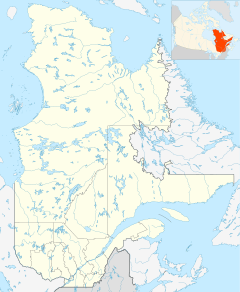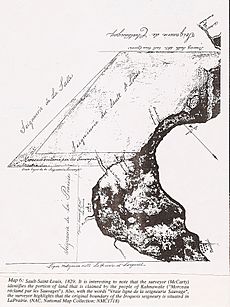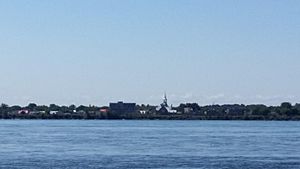Kahnawake facts for kids
Quick facts for kids
Kahnawake
Caughnawaga
|
|
|---|---|
| Kahnawake First Nations Reserve No. 14 | |
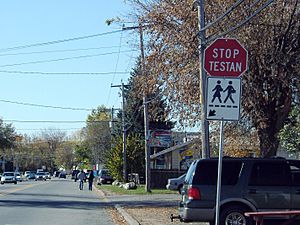 |
|

Location of Kahnawake, outside of Roussillon RCM.
|
|
| Country | Canada |
| Province | Quebec |
| Region | Montérégie |
| RCM | Roussillon Within RCM, but unassociated |
| Electoral Districts Federal |
La-Prairie |
| Provincial | Châteauguay |
| Government | |
| • Type | Band council |
| Area | |
| • Land | 50.41 km2 (19.46 sq mi) |
| Population
(2022)
|
|
| • Total | 7,965 |
| • Pop 2006-2011 | N/A |
| • Dwellings | N/A |
| Demonym(s) | Kahnawakeronon |
| Time zone | UTC−05:00 (EST) |
| • Summer (DST) | UTC−04:00 (EDT) |
| Postal code(s) |
J0L1B0
|
| Area code(s) | 450 |
| Highways | |
| Website | www.kahnawake.com |
Kahnawake is a special territory for the Mohawk people. It is a First Nations reserve located on the south side of the Saint Lawrence River in Quebec, Canada. It sits right across from the city of Montreal.
The French first set up Kahnawake in 1719 as a Christian mission. It was also known as Caughnawaga for a long time. The name Kahnawake comes from the Mohawk language and means "place of the rapids." This refers to the fast-moving water of the Saint Lawrence River nearby.
Today, Kahnawake covers about 48 square kilometers (18.5 square miles). Over 8,000 people live there, though some Mohawk people from Kahnawake live outside the reserve. The land rules here are different from other parts of Canada because of the federal Indian Act. Most residents used to speak the Mohawk language. Now, most people speak English.
The Mohawk people call themselves Kanien’kehá:ka, which means "People of the Flint." They were known as the "Keepers of the Eastern Door" because they lived on the eastern edge of the Haudenosaunee (Six Nations Iroquois Confederacy). They protected the other nations from attacks.
Kahnawake is one of several self-governing Mohawk territories in Canada. Others include Kanesatake and Akwesasne.
Contents
- Where is Kahnawake Located?
- Understanding Historical Land Claims
- A Community with Many Roots
- Building Projects and Their Impact
- Mohawk Ironworkers in New York
- Kahnawake Today: Community and Rules
- Online Gaming Industry
- Kahnawake Flag Around the World
- Important Historic Sites
- Kahnawake in Movies and TV
- Famous People from Kahnawake
- Media Outlets in Kahnawake
- Kahnawake Powwow
- Schools in Kahnawake
- See also
Where is Kahnawake Located?
Kahnawake is found on the southwest shore where the Saint Lawrence River gets narrower. The Mohawk name for the area means "on, or by the rapids" of the Saint Lawrence River. This shows how important the river and its rapids were to the community.
In the past, the French colony of New France used Kahnawake as a defense point for Montreal. They had a military garrison there. The Jesuits also started a Christian mission to work with the local Mohawk and other First Nations. This mission began around 1719.
Understanding Historical Land Claims
Kahnawake was created under a system called the Seigneurial system of New France. In 1680, the French Crown gave about 40,320 acres of land to the Jesuits. This was meant to protect and support Mohawk people who had become Catholic. The government wanted this land to be only for Indigenous people.
However, the Jesuits, who managed the land, allowed French and other European settlers to live there and pay rent. This was not what the Crown intended.
After the British took control in 1762, the new governor said the land should belong only to the Mohawk people. But many government agents still allowed non-Native people to use the land. They also managed the land and rents poorly. Over time, the Mohawk people lost much of their land. From the late 1880s to the 1950s, they had to give up land for railways, power lines, and telephone projects.
Today, Kahnawake has only about 13,000 acres left. The Mohawk Nation is now working with the Canadian government to get back the land they lost. They are asking for money and official recognition of their claim.
A Community with Many Roots
Kahnawake has always been a place where different Indigenous peoples came together. The Mohawk people often adopted captives into their tribes, especially women and children. This helped replace people lost to sickness or war. These adopted individuals became full members of the Mohawk families and clans. This practice happened even before Europeans arrived.
Over time, some Europeans also settled in Kahnawake. Many marriages happened between European men and Indigenous women. Children born to Mohawk mothers were always considered part of the mother's clan and nation. This is because the Mohawk have a matrilineal system, where family ties and status come from the mother.
In the 17th and 18th centuries, the English and French were often at war. They and their Indigenous allies would raid each other's territories. Sometimes, captives were taken. For example, after a raid in 1704, over 100 people were brought to Montreal and Kahnawake. One teenage girl chose to stay with her new Mohawk family instead of returning home.
Because of this history, many Kahnawake people have mixed ancestry but still identify as Mohawk. They might have roots from other Iroquois tribes, or from French, English, or Scottish families. By the 1790s, visitors often noticed the "great mixture of blood" in Kahnawake. They saw many children who looked European but were being raised as Mohawk.
Some Kahnawake family names, like Beauvais, Johnson, McComber, and Tarbell, show this history of adoption and marriage with non-Natives. For example, the Tarbell brothers were captured from Massachusetts as children in 1707. They were adopted by Mohawk families, learned Mohawk ways, and even became chiefs themselves.
Building Projects and Their Impact
Historically, large building projects that helped southern Quebec were often built on Kahnawake land. This was because of its location near the Saint Lawrence River. The reserve is now crossed by power lines, railways, highways, and bridges.
One of the first big projects was the Canadian Pacific Railway's bridge across the Saint Lawrence River in 1886-1887. Many Kahnawake men worked on this bridge as ironworkers. They worked hundreds of feet above the water.
Later, when the Saint Lawrence Seaway canal was built, it cut through the village. This separated the people and their homes from the natural river shore. Losing land and access to the river had a huge impact on Kahnawake. The community had lived by the river for hundreds of years. But these challenges also made the community stronger and more determined to protect their land.
Mohawk Ironworkers in New York
Mohawk men became famous for their skill and bravery in building tall structures. They were known as "skywalkers." Sadly, 33 Kahnawake (Mohawk) men died when the Quebec Bridge collapsed in 1907. This was a terrible loss for the small community. They put up steel crosses at both ends of the reserve to remember them.
Many Kahnawake ironworkers went to New York City in the early 1900s. They helped build famous skyscrapers like the Empire State Building and many bridges. They brought their families with them and lived in a neighborhood in Brooklyn they called "Little Caughnawaga." While the men worked, the women built a strong community for their families. In the summers, families would return to Kahnawake to visit relatives.
Kahnawake Today: Community and Rules
The elected Mohawk Council of Kahnawake (MCK) is the main governing body of the reserve. They work with the Canadian government.
Who Can Live in Kahnawake?
In the late 20th century, the Mohawk Council of Kahnawake made rules about who could live on the reserve. In 1981, they passed a law saying that non-Native people could not live in the community. This also meant that Mohawk people who married someone who was not Mohawk might lose their right to live in their homeland. The MCK said this rule was to protect their culture and identity.
This policy is based on a community decision from 1981. In 2010, the MCK decided to ask 35 non-Natives to leave the reserve. This caused a lot of discussion. Some people felt it was unfair, especially for those who had lived there for many years. But the council said they were responding to complaints from residents about limited housing and land.
The Canadian Human Rights Tribunal has ruled that the Kahnawake government can make policies to help their people survive. The Federal Indian Affairs Minister, Chuck Strahl, also said that the band's actions were legal. He stated that these decisions are made by First Nations people on their own land.
However, some Mohawk leaders, like Ellen Gabriel, have criticized these rules. She said that Mohawk communities have always welcomed and integrated new people, and that this policy goes against their traditions.
Bringing Back Traditional Justice
Before Europeans arrived, the Iroquois Confederacy had its own way of handling justice. It was based on clans and councils. The goal was to bring peace back to the community and control behavior that caused problems. This system used principles like reason, persuasion, and making things right.
Many people in Kahnawake believe the Canadian justice system does not serve their people well. They are trying to bring back Skenn:en A'onsonton (to become peaceful again), which is the traditional Iroquois justice system. This system aims to resolve problems and restore harmony, rather than just punishing people. It helps both the person who caused harm and the person who was harmed work together to find a solution.
Online Gaming Industry
The Kahnawake Gaming Commission gives licenses to online gambling websites for poker, casino games, and sports betting. This has made Kahnawake an important player in the online gaming business.
Mohawk Internet Technologies (MIT) is a local data center in Kahnawake. It hosts and manages many online gambling websites. This provides high-tech jobs for people in the community. MIT started in 1998 and has become very successful.
Kahnawake Flag Around the World
In 2007, two ships from the Sea Shepherd Conservation Society flew the Kahnawake Mohawk flag. This means the Kahnawake Mohawk nation is the only Indigenous American nation to have its flag on deep-sea ships.
Important Historic Sites
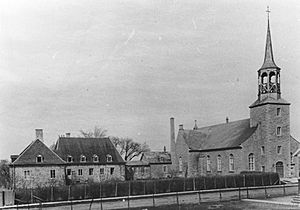
Kahnawake has three National Historic Sites of Canada:
- Fort St-Louis
- The Jesuit Mission of St-François-Xavier
- The Caughnawaga Presbytery
Kahnawake in Movies and TV
- Little Caughnawaga: To Brooklyn and Back (2008) is a documentary by Reaghan Tarbell, a Kahnawake native. It tells the story of Kahnawake families who moved to New York for work.
- The movie Beans (2020) by Tracey Deer explores the 1990 Oka Crisis. It shows the events through the eyes of a young girl from Kahnawake.
Famous People from Kahnawake
- Taiaiake Alfred (born 1964), a professor and activist.
- Tracey Deer, a filmmaker who won awards for her documentaries and TV series Mohawk Girls.
- Mary Two-Axe Earley (1911–1996), a champion for Native Women's rights.
- Kaniehtiio Horn, an actress.
- Waneek Horn-Miller, an Olympic water polo player.
- Kawennáhere Devery Jacobs, an actress, writer, and director.
- Alwyn Morris (born 1957), an Olympic canoeist and kayaker who won a gold medal.
- Alex Rice (born 1972), an actress in many TV shows and movies.
- Kateri Tekakwitha (1656–1680), the first Native American Catholic saint.
- Billy Two Rivers, a professional wrestler and actor.
Media Outlets in Kahnawake
Kahnawake has its own local media:
- CKKI-FM 89.9 FM (89.9 KiC Country Montreal)
- CKRK-FM 103.7 FM (K1037 Kahnawake)
- Mohawk TV, a community TV station.
- Iorì:wase, a print and online newspaper.
- The Eastern Door, a weekly newspaper.
Kahnawake Powwow
Every summer, a powwow is held on the second weekend of July at Kateri Tekakwitha Island. It is a fun event open to everyone. People can enjoy traditional foods, handmade crafts, singing, and dancing. It's a great way to share and experience Native American culture.
Schools in Kahnawake
Kahnawake has several schools for different age groups:
- Step By Step Child and Family Center (early learning)
- Kateri School (elementary)
- Karonhianonhnha School (elementary)
- Indian Way School (elementary)
- Karihwanoron Mohawk Immersion School (elementary, teaches in Mohawk language)
- Kahnawake Learning Center (general education, high school)
- Kahnawake Survival School (high school)
- FNRAEC (First Nations Adult Education Center)
See also
 In Spanish: Kahnawake para niños
In Spanish: Kahnawake para niños



